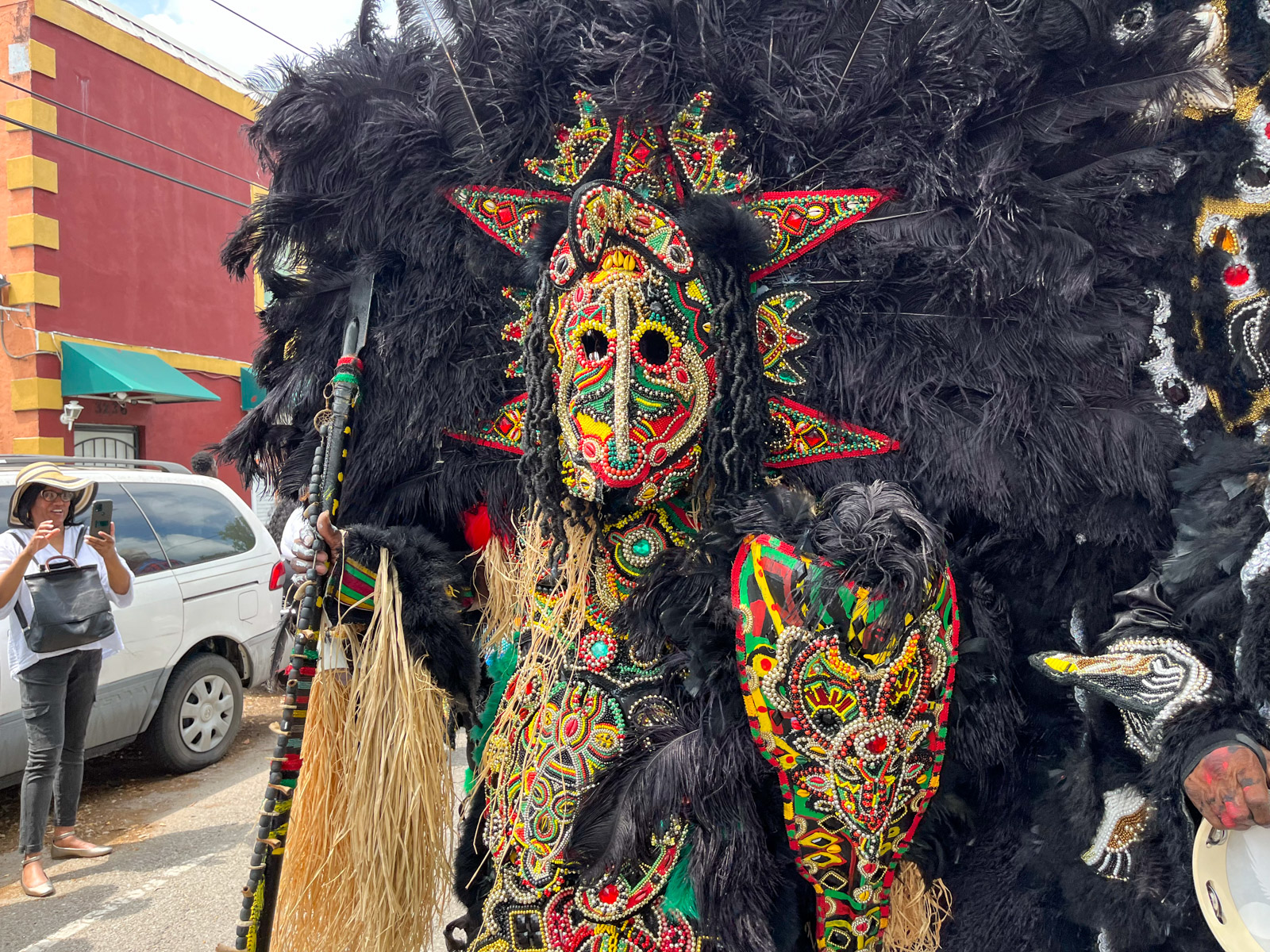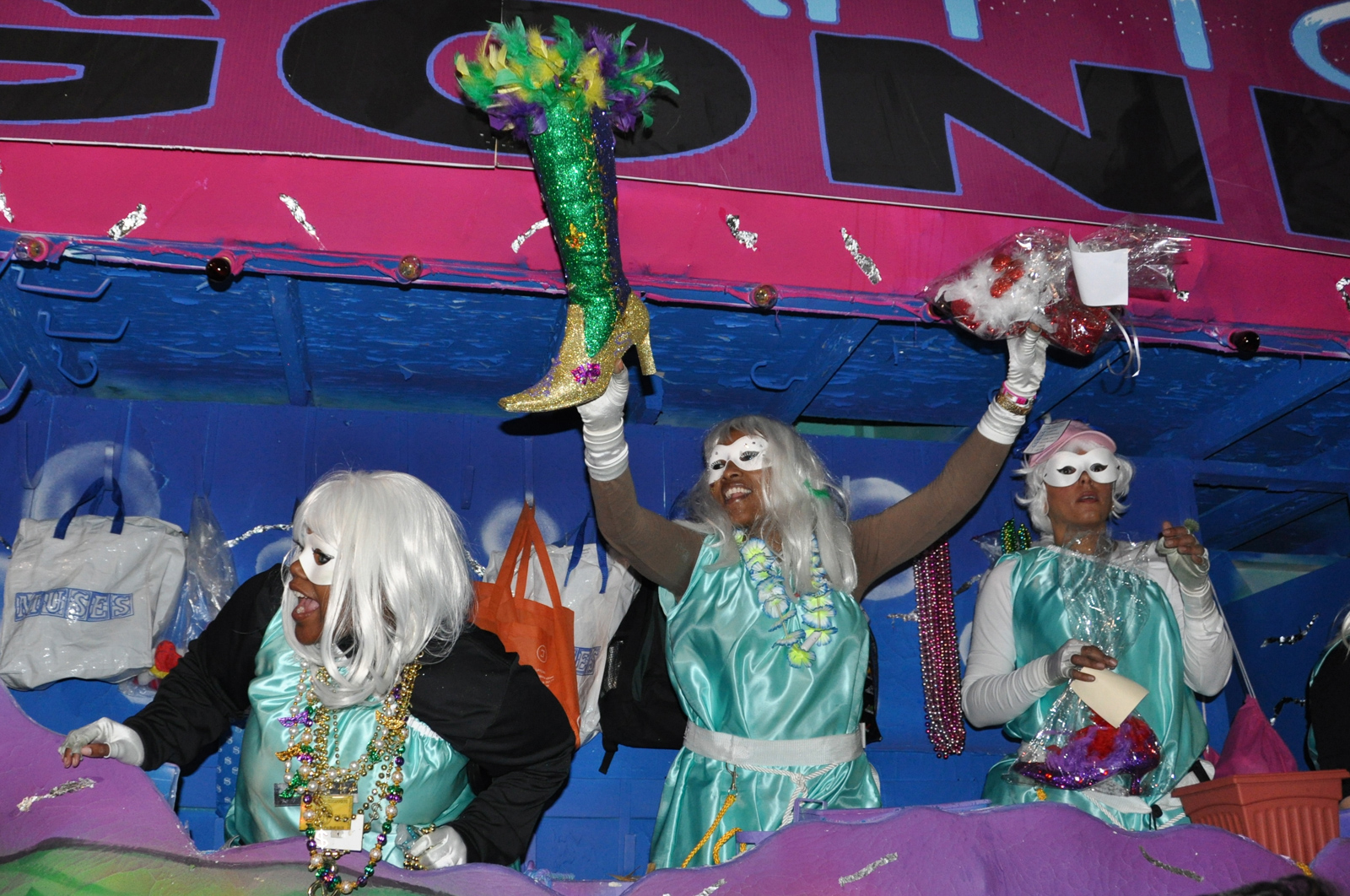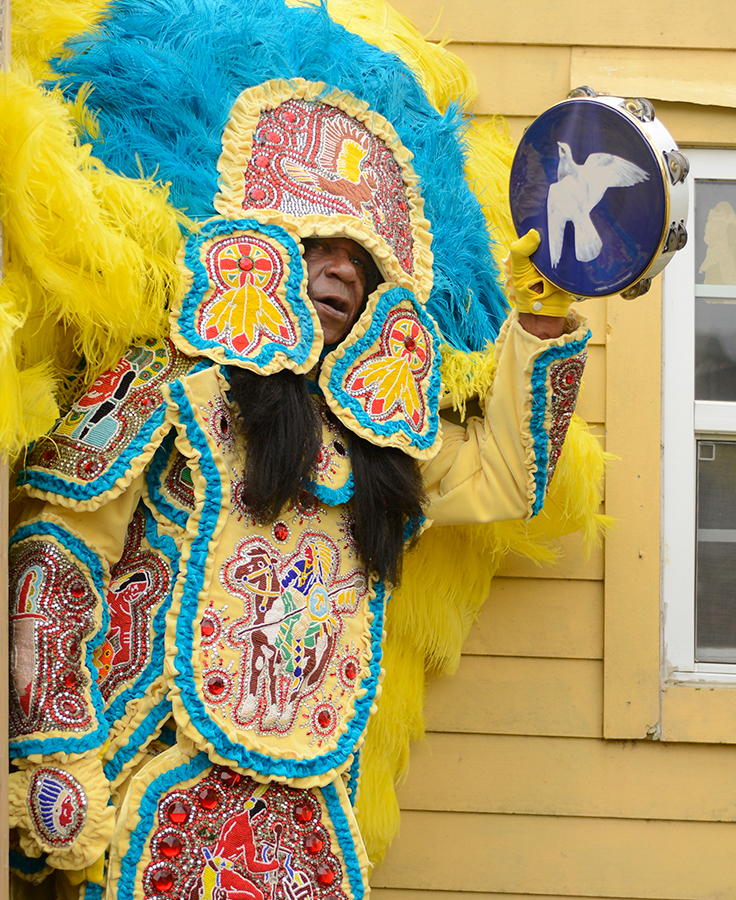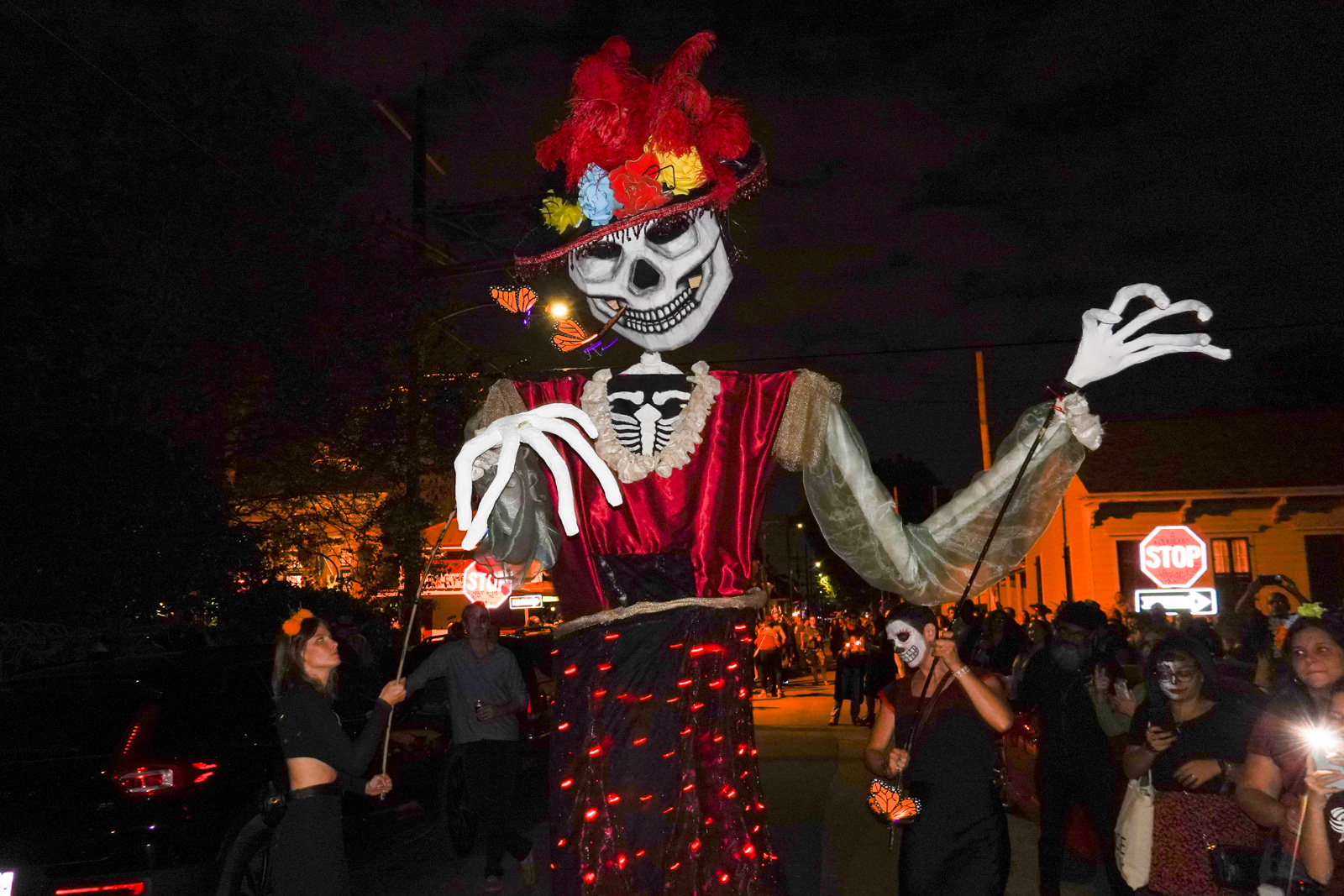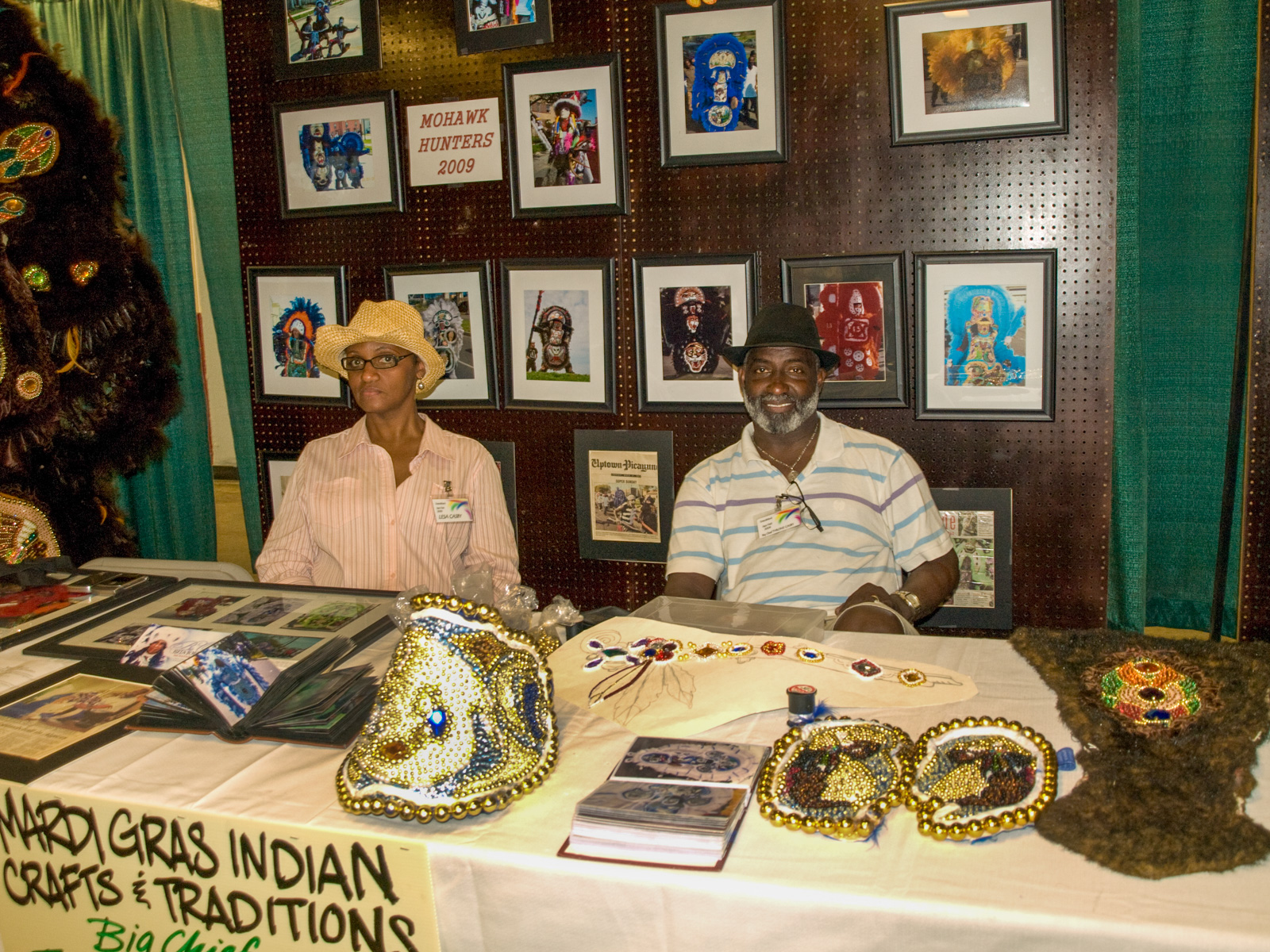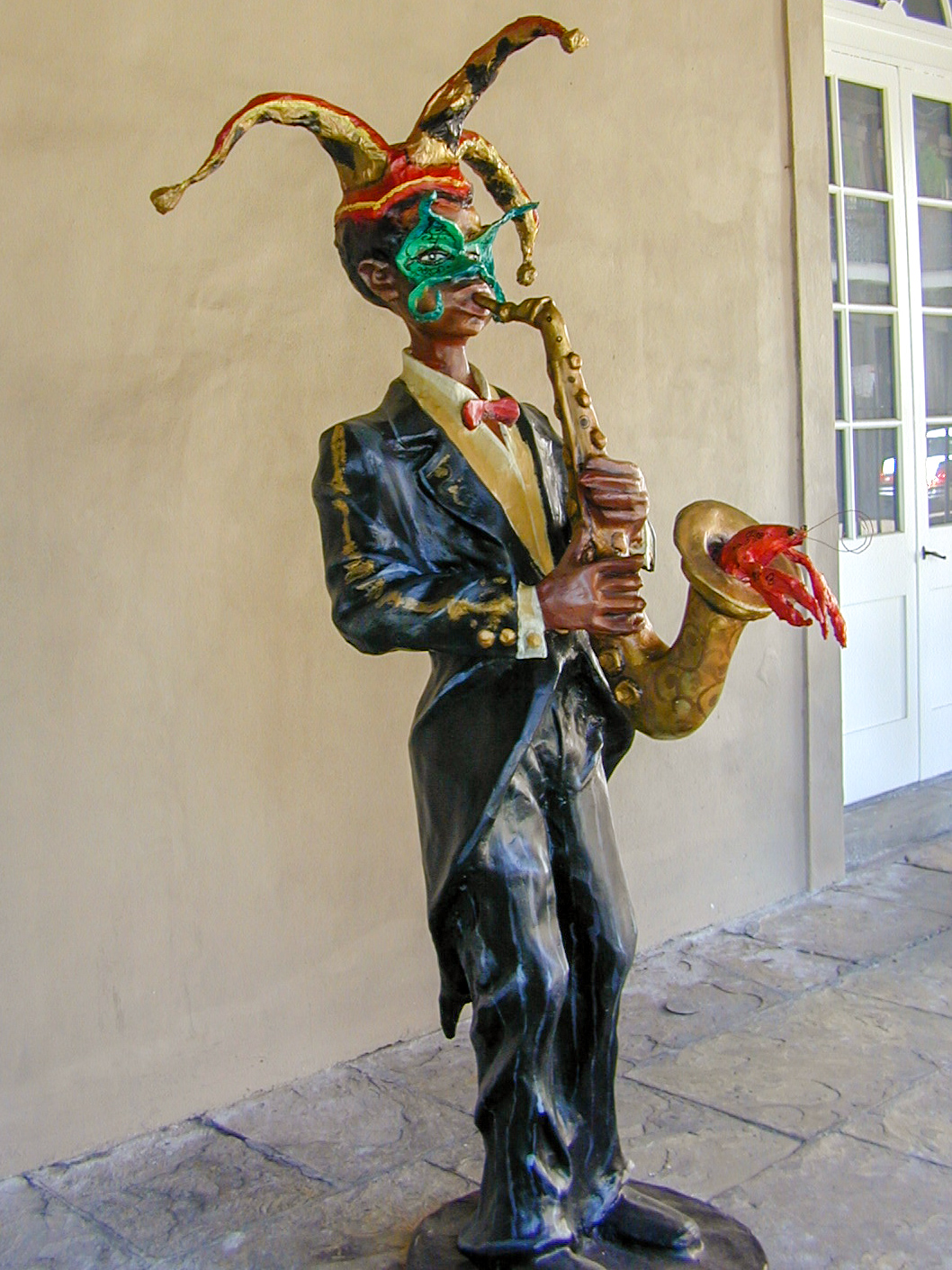Jazz Fest has consistently showcased aspects of Carnival, notably performances and parades by New Orleans’s iconic Mardi Gras Indian tribes. But there’s much else of interest for those curious about the city’s annual outburst of creative expression.
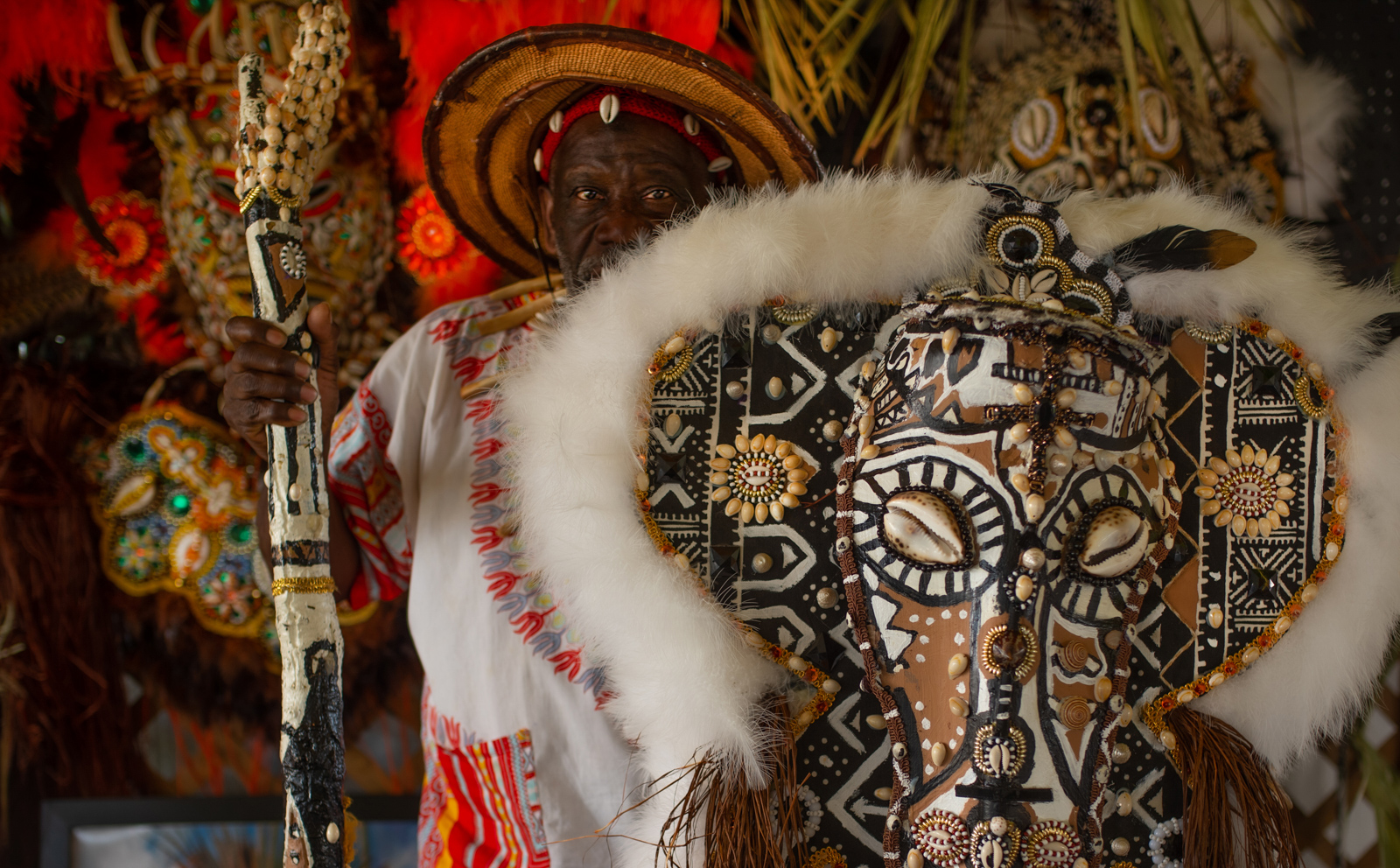
Big Chief Fi Yi Yi Victor Harris in the Jazz Fest Folklife Village, 2022
An oasis from crowds and sun that also affords festivalgoers an opportunity to meet esteemed artisans who love to share their crafts and cultures.
Muses shoes and more add flavor to the Fest
By Graham Button
No two events have done more to draw attention to Louisiana’s special flavor than Mardi Gras and the New Orleans Jazz and Heritage Festival. Visitors initially drawn to one of the sensory feasts often find themselves wanting a taste of the other.
Jazz Fest, the much-younger sibling, has consistently showcased aspects of Mardi Gras, notably performances and parades by the city’s iconic Mardi Gras Indian tribes. But there’s much else of interest for those curious about, or already initiated into, the seasonal rites of pre-Lenten merriment (Carnival) that culminate on Mardi Gras (aka Fat Tuesday, Mardi Gras Day or Carnival Day).
Over the years, a wealth of exhibits, interviews and moderated panel discussions, presented in the Fairgrounds grandstand, have cast light on why Carnival/Mardi Gras (the terms are often used interchangeably) arouses so much creative passion and even spiritual devotion, expressed through a nuanced mosaic of art forms and rituals, cultures and subcultures. Which is another way of saying that, for many, it’s about much more than parades and just having fun.
The Louisiana Folklife Village, an area comprised of tents and an open space in the Fairgrounds’ infield, offers demonstrations and exhibits by a variety of artisans including those who make Mardi Gras magic. It’s an oasis for festivalgoers seeking refuge from the crowds and sun and want a taste of traditional folk arts and idiosyncratic creative pursuits. The Native American Village within the Folklife Village focuses on Louisiana’s rich indigenous heritage and presents craft demonstrations, drumming and powwow performances featuring colorful regalia and dancing.
Check out what Jazz Fest has in store at the 2024 Folklife Village, a window on the myriad of cultures that call Louisiana and New Orleans home. Some highlights that bring into focus the importance of Mardi Gras to the region’s cultural identity:
Revisiting a folklife incubator (April 25-28)
The mermaids at the entrance to the 1984 World’s Fair
Jazz Fest 2024 will salute the artistry of the Barth family and the legacy of the fair’s Louisiana folklife component.
Jazz Fest is tipping its hat to the Louisiana World Exposition, more commonly known as the 1984 World’s Fair, where the original Louisiana Folklife Festival debuted — “bringing tradition bearers from across the state together [and] laying the foundation for many to become fixtures at Jazz Fest as regular demonstrators,” according to Jazz Fest’s website.
Tent D will offer a salute to the Barth family, whose legacy includes building floats for Mardi Gras parades and the mermaids sculpture at the front entrance to the fair. The sculpture, 25 feet high and 40 feet long, brought the small family business considerable notoriety and opened doors to more work outside of Mardi Gras.
“Oh, the mermaids. My word, the mermaids,” Ron Cuccia, writing in Houston City Magazine, rhapsodized. “Cast from the core of New Orleans’ sensuality, they best represent America’s sexiest city. Without a hint of guilt or shame, they sit atop the gate bare-bottomed and abundant, dangling pearls about their luxurious breasts. They smile languidly. They are the essence of invitation. They are true and first-rate folk art.”
Victor Harris of the Mandingo Warriors – Spirit of Fi Yi Yi (April 25-28)
On Mardi Gras, it’s not easy getting near Victor Harris, let alone meeting him and putting your arm around him for a photo. He’s Big Chief Fi Yi Yi. When he puts on his eye-popping “suit” and hits the street with his tribe, he experiences a spiritual transformation and communion with African ancestors. People hear the “Fi Yi Yi” chant and come running, as if to receive a blessing. The crowd, in a frenzy of excitement, surges around him.
Big Chief Fi Yi Yi, Downtown Super Sunday 2024
Believed to be the longest continuously masking Black Indian in the history of New Orleans, his style is distinctly African.
Said to be the longest continuously masking Indian in the history of New Orleans, Harris is a celebrated icon in a stacked pantheon. He has masked for 59 consecutive years, beginning in 1965, at age 15, with the Yellow Pocahontas under legendary Big Chief Allison “Tootie” Montana. Since 1984, he’s been making a name for himself as Chief of the Mandingo Warriors – Spirit of Fi Yi Yi. This year marked his 40th (and last?) appearance as Chief on Mardi Gras. He’s being succeeded by his son Victor Harris, Jr., aka Little Vic.
Out of a suit, Victor Sr. is genial and approachable. In Tent C, he’ll display his regalia and gladly discuss his craft and community-minded mission in life.
His suits are something to behold. Departing from the open-face crowns typically worn by those who “mask Indian” — a style derived from Native Americans — he favors stunning, African-style masks that completely cover his head. His suits are also notable for intricate, abstract designs and their use of palm leaves, cowrie shells and corn-husk ribbons.
At 12:35 on Sunday, April 28, the Mandingo Warriors – Spirit of Fi Yi Yi will perform on the Jazz and Heritage Stage.
Krewe of Muses Glitter Treasures (April 25-28)
Joining Harris in Tent C will be members of the all-female Krewe of Muses, decorating and showing off their glittering shoes and boots. These folk-art “throws,” bestowed by float riders on covetous parade-goers, were inspired by the signature coconuts of the Zulu Social Aid and Pleasure Club — the original DIY Carnival keepsakes.
Riders in the 2012 Muses parade
Glitter fuels the creativity that goes into making their coveted booty.
Photo © Graham Button
Muses, which debuted in 2000, is named after the Greek mythological Muses — collectively, the nine daughters of Zeus and Mnemosyne. They’re said to have inspired artists and poets, musicians and dancers, philosophers and scientists.
The Muses of Mardi Gras, in addition to their high-heel footwear fetish, are known for sassy, satirical parade themes and members creating headdresses that complement the depictions of the specific floats on which they ride, as well as for recruiting a bevy of inspired marching and dance troupes.
Like Carnival itself, the creativity that goes into making the prized shoes and boots practically knows no bounds. Wild flights of fancy and stunning variety, in terms of both materials and concept, are de rigeur. No doubt Clio, Terpsichore, Erato, Calliope and the rest of the ancient Muses, all of whom are represented in the names of New Orleans streets, would be pleased at what they’ve wrought in the realm of Glitter Queens and Mardi Gras dreams.
Monk Boudreaux & family (April 26 and 28, May 4)
Fans of Mardi Gras Indians won’t want to miss the Boudreaux family interview, on the Alison Miner Music Heritage Stage in the grandstand (Friday, April 26; 4:30 pm). Three generations will have their say: Joseph Pierre “Monk” Boudreaux leads the Golden Eagles and, at 82, is the oldest living Mardi Gras Indian Chief. He’ll be joined by his son Joseph “Bugga” Boudreaux, Jr. and grandson J’wan Boudreaux.
Big Chief Monk Boudreaux, Mardi Gras 2013
He began his prolific performing and recording career more than a half century ago and has an uncanny ability to make up rhymes and lyrics on the fly.
Big Chief Monk is a beloved culture bearer with Native heritage and ancestral ties to Houma, a community southwest of New Orleans in the bayous of Terrebonne Parish. In an interview with Jack Dappa Blues Radio & TV, he said his family “migrated during the time when things was rough for the Indians, so they came to New Orleans and they passed off as black because they was dark skin. And they never talked about it, they never mentioned it, because they were scared because they didn’t want to get sent to the reservation.” His father, Raymond, masked with the Wild Squatoolas tribe.
Monk Boudreaux began his career in music in the early 1970s, performing and recording alongside Theodore Emile “Bo” Dollis in the Wild Magnolias band (identified with, but mostly separate from, the street-masking tribe of the same name under Big Chief Bo). It’s hardly a stretch to say that the Wild Magnolias’ self-titled debut LP, initially released in France and picked up for U.S. distribution by Polydor Records in 1974, turned the world onto Mardi Gras Indian music. It was the first LP collaboration between Indians and top New Orleans musicians steeped in funk, jazz and R&B.
Monk is one of three masking Indians to have received a National Heritage Fellowship from the National Endowment for the Arts, considered the nation’s top honor in folk and traditional arts. (Dollis (1944-2015) and Tootie Montana (1922-2005) are also recipients.) Big Chief Monk Boudreaux & the Golden Eagles will perform on the Jazz and Heritage Stage on Sunday, April 28 at 4:30.
Monk’s 2021 Reggae-inflected album Bloodstains & Teardrops — recorded, in part, in Kingston, Jamacia — received a Grammy nomination, in the Best Regional Roots Album category. Also nominated in the same category was Cha Wa for My People, the follow up to its Grammy-nominated 2018 album Spyboy. Golden Eagles Spyboy J’wan Boudreaux was lead vocalist on Spyboy; Monk appeared as a guest vocalist. My People featured both J’wan and his uncle Joseph Jr., who is Second Chief of the Golden Eagles, on vocals. (When a masking Indian hollers “Cha-WAHHHH!!!” it means “We’re comin’ for ya!” or “Here we come!”)
In late 2021, Joseph Jr. and most of his bandmates left Cha Wa to form The Rumble. Its debut album, Live at the Maple Leaf, received a Grammy nomination for Best Regional Roots Album 2024. The Rumble will perform the second weekend of Jazz Fest, on Saturday, May 4 at 12:40 on the Congo Square Stage.
Honey Banister and Cha Wa (April 25 and 26)
J’wan Boudreaux and Irving “Honey” Banister, Jr. shared lead vocal duties on Cha Wa’s debut album, 2015’s Funk ‘N’ Feathers. The band’s current lineup includes its founder, drummer Joe Gelini, and Banister as frontman.
Banister is a natural showman with deep roots in the music and Mardi Gras Indian traditions of New Orleans. He’s the son of guitarist Irving Banister, Sr., who played with a galaxy of legends including Ruth Brown, Dr. John, Sugar Boy Crawford, Eddie Bo, Smiley Lewis, Charles Brown, Danny White, Smokey Johnson, George Porter, Jr., Irma Thomas, Johnny Adams, Lee Dorsey, Ernie K-Doe and Solomon Burke.
Irving “Honey” Banister, Jr., Mardi Gras 2016
A natural showman deeply rooted in the music and Mardi Gras Indian traditions of New Orleans, he fronts the band Cha Wa.
Irving Sr. died in 2020. His last recording was playing rhythm guitar on a remake of Sugar Boy Crawford’s classic 1954 Carnival anthem “Jock-A-Mo,” included on Funk ‘N’ Feathers. The track features Sugar Boy’s grandson Davell Crawford on lead vocal.
Honey first masked with the Creole Wild West as a six-year-old Chief Scout under Big Chief Bruce Gaten in 1973, and later ran Spyboy and Gang Flag under Big Chief Lil Walter Cook. For many years, his mom, Littdell “Queen B” Banister, who has Choctaw heritage, masked with him in the Creole Wild West, widely regarded as the oldest Mardi Gras Indian tribe. Honey toured extensively with the Wild Magnolias band. In 2023, he made his 50th consecutive year masking Indian.
At Jazz Fest, Cha Wa will take the Congo Square Stage at 2:25 on Thursday, April 25. The following day, at 11:20, Honey will join the Comanche Hunters Mardi Gras Indians, under Big Chief Keith “Ke Ke” Gibson, for a performance on the Jazz and Heritage Stage. Then at 2 o’clock, he’ll parade in the Fairgrounds infield with the Golden Sioux.
Over the course of the eight-day festival, some 32 tribes will parade. Check the Cubes or download the Jazz Fest app for a complete schedule of parades and performances. (All parades begin next to the Jazz and Heritage Stage.) (festival map)
Cha Wa and The Rumble offer a modern twist on the Mardi Gras Indian street sound, blending second-line beats with New Orleans funk, R&B and other flavors conjured with contributions from keyboards, horns and electric bass and guitar. The Creole Wild West, by contrast, is traditional in its approach, utilizing only hand percussion along with drums and congas when performing on stage. The tribe performs on the Jazz and Heritage Stage on Saturday, April 27 at 11:20 am.
Bruce “Sunpie” Barnes, the Northside Skull & Bone Gang (April 27, 28)
On Sunday, April 28, beginning at 4:30, members of the Northside Skull and Bone Gang will parade their way through the infield, wearing oversized skull heads and aprons scrawled with skulls, bones and their signature catchphrase: “You Next.” Their regalia might include serious-looking spears made with antelope horns and a big, bloody meat bone or two. Their Chief is Bruce “Sunpie” Barnes, who has been known to adorn himself with huge alligator teeth and have the horns of an African water buffalo protruding from his skull head.
Big Chief Sunpie, Mardi Gras 2019
The Northside Skull and Bone Gang’s admonitions of mortality are mixed with interludes of dance.
In New Orleans, skull-and-bone masking on Mardi Gras goes way back. The maskers would dye long johns black and paint bones on them. They sculpted skull heads using wire covered with cheese cloth, then applied multiple coats of white enamel. It was an inexpensive way for black men to mask, at a time when members of their race were not welcomed in the “official” celebration. The skeleton men would wake up the Tremé neighborhood and scare children, warning of a comeuppance if they didn’t stay in school and out of trouble.
Sunpie and his gang — which includes his son Aurélien, trumpeter for The Rumble — hit the streets of Tremé before dawn on Mardi Gras, with a contingent of African drummers who command considerable attention. Periodically, the group pauses to initiate a drum circle. Individual who gamely step in and strut their stuff, draw cheers.
Sunpie’s songs, raps and admonitions — about caring for one another and getting right with yourself and the world before it’s “too late” and the bone man cometh — have a way of cutting to the bone. But, as the drum circles attest, there’s also an underlying message about enjoying today what might be gone tomorrow.
When he’s not donning a handmade skull head, Sunpie wears many other hats including those of recording artist and band leader. He’s developed a genre he calls “Afro-Louisiana music,” incorporating Louisiana Creole with blues, zydeco, gospel, Caribbean and African music. Sunpie and the Louisiana Sunspots perform in the Blues Tent on Saturday, April 27 at 4:20.
Krewe de Mayahuel (May 2-5)
In Louisiana, Mardi Gras represents hundreds of years of tradition but is always evolving to reflect changing local demographics and what’s happening in society more broadly. A constant influx of new groups channel the true spirit of Mardi Gras as a great equalizer, belonging to the people and open to all who want to participate and do their thing.
Krewe de Mayahuel’s La Catrina skeleton puppet in the 2022 New Orleans Dia de los Muertos parade
The walking krewe, which celebrates Mexican folklore and culture, is as much a craft collective as it is a parading and social organization.
Photo © Graham Button
Krewe de Mayahuel, a relative newcomer, has put itself on the map by organizing a popular Dia de los Muertos (Day of the Dead) parade and adding a Mexican twist to Carnival parades including krewedelusion, Red Beans and Mosaique. The group, which has a folkloric bent, takes its name from the Aztec goddess of the agave plant, used to make tequila, mezcal and pulque.
The walking krewe formed around 2017 to bring people of Latin heritage together, represent Mexican culture and counter negative stereotypes about immigrants. Co-founder Roberto Carrillo, a native of Mexico City, moved to New Orleans in 2005 from Philadelphia, just before Hurricane Katrina. “Parading is the soul of New Orleans, you show the world what you think,” he told the Washington Post in 2019. Mayahuel based its parade theme that year on Mexican artists Diego Rivera and Frida Kahlo. (The krewe honored Carrillo, who died in April 2023, at age 56, at last year’s Dia de los Muertos parade.)
Mayahuel is as much a craft collective as it is a parading and social organization. Everyone pitches in to make what they need including costumes, throws, giant papier-mâché puppets and an Aztec pyramid float. The DIY ethos makes for a nice fit with the Folklife Village. See what they have going on during the second weekend of the festival in Tent C.
Tyrone Casby – Mohawk Hunters Mardi Gras Indians (May 2-5)
As a teenager in 1967, Tyrone Casby snuck out of his mom’s house to build his first Mardi Gras Indian suit. He’d been drawn to the Indians and their drumming since boyhood, but the tribes had a sketchy reputation. They referred to themselves as “gangs” and were still associated, in the public’s mind, with a history of altercations and trouble — even though competition between them had shifted to vying to outshine one another with magnificently bejeweled and feathered suits.
Lesa Casby and her husband, Big Chief Tyrone Casby, exhibiting at Jazz Fest 2009
He enjoys interacting with visitors and sharing his love for Mardi Gras Indian masking, a tradition still misunderstood and underappreciated, even by some locals.
Hence the need, in Casby’s case, for stealth so as not to worry his mom.
Today, Casby is a venerated elder with passions for Indian masking and cultural heritage preservation as well as education and working with at-risk youth. A veteran educator, he rose from substitute teacher to principal of his alma mater, now called Landry-Walker College and Career Preparatory High School. He’s been Big Chief of the Mohawk Hunters, among the largest tribes in the city, since 1980. Multiple generations of his family, as well people with professional occupations, figure prominently in the tribe, which is based on the West Bank — across the Mississippi River from the areas of the city that almost all other tribes call home.
The Big Chief, who made his 50th year masking in 2017, has long been a pillar of the Folklife Village. He relishes the opportunity to interact with visitors from all over the world — and share his love for a culture still misunderstood and often underappreciated, even by some locals. Making a suit year after year after year requires extraordinary discipline and sacrifice, and wearing it is not something undertaken in the spirit of lighthearted frivolity usually associated with Mardi Gras. Although sometimes misconstrued a cultural appropriation or a fantasy masquerade, “masking Indian” is, in fact, a deeply rooted sacred endeavor honoring ancestors who were enslaved and had their land stolen.
Big Chief Casby is uniquely qualified to separate perception from reality and put the tradition in a cogent historical and educational context. Visit him in Tent C at the Folklife Village during the second weekend of the festival.
Tana Barth (May 2–5)
Also in Tent C, Tana Barth — a veteran sculptor who worked on the famous mermaids for the entrance of the 1984 World’s Fair — will demonstrate the papier-mâché technique pioneered by her family.
A Barth sculpture
Tana Barth will be on hand the second weekend of Jazz Fest to demonstrate the “direct method” papier-mâché technique.
Photo © Graham Button
Papier-mâché, a French term meaning “chewed paper,” has long been associated with the art of Carnival. For the earliest New Orleans parades, papier-mâché float props and walking heads were imported from France. In the late 19th and early 20th century, a local industry developed to the point where entire floats (except for the chassis) were sculpted using traditional papier-mâché methods, passed down from one artist to another.
Eventually, in part because papier-mâché was time-consuming and therefore expensive, the adoption of mass-produced figures, pre-fabrication and air-brush painting compromised artistic quality.
In 1975, Tana’s father, Joe Barth, Jr., along with his sons Joseph III and Barry, opened Barth Bros., a concern dedicated to the ancient craft. Joe III drew on Joe Jr.’s work as a float builder and scenic designer, utilizing cardboard treated with contact cement, to come up with the so-called “dry” or “direct method,” whereby adhesive is applied to both sides of brown craft paper, then hung up to dry. Sticking to itself but not one’s hands, it could be layered, crumpled and shaped into sculptures and then painted. Because the adhesive-coated paper is malleable and could thus be molded directly, it largely eliminated the need for any significant sub-sculpture or armature fabricated with unwieldy chicken wire and layers of wet papier-mâché.
Today, the direct method is used by Royal Artists to build, among other Mardi Gras parades, Rex and Proteus, which hark back to the Golden Age of Carnival design and craftsmanship.
MardiGrasTraditions.com
© 2021-2024 Mardi Gras Unmasked, LLC


